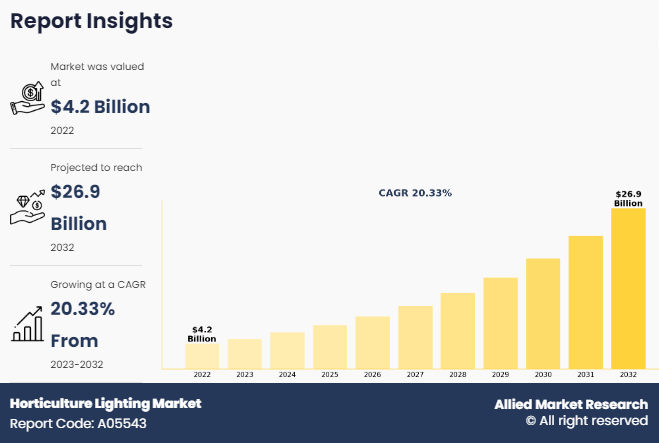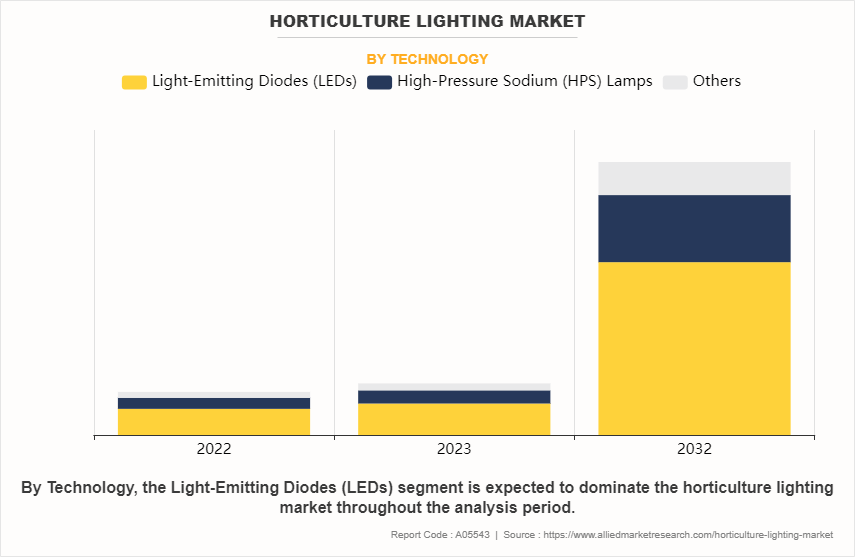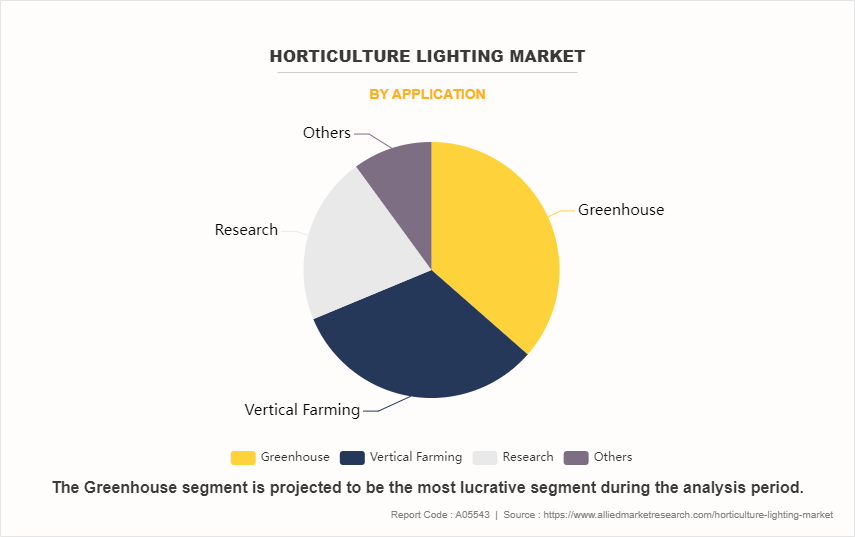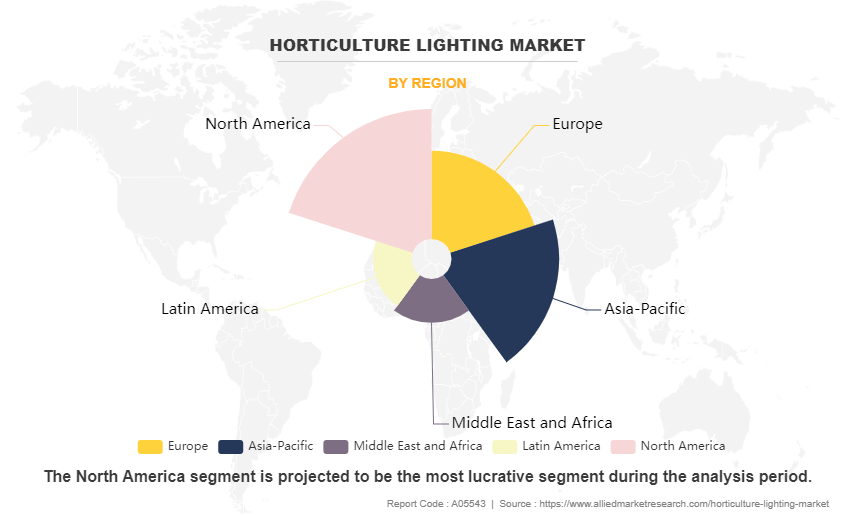Horticulture Lighting Market Research, 2032
The global Horticulture Lighting Market was valued at $4.2 billion in 2022 and is projected to reach $26.9 billion by 2032, growing at a CAGR of 20.3% from 2023 to 2032.
Horticulture lighting manufacturer provides la ighting system that helps to produce fruits, vegetables, and herbs locally, reducing transportation costs and carbon emissions associated with long-distance food distribution.

Horticulture lighting employs artificial light sources to increase the growth and progress of plants within controlled environments such as greenhouses, vertical farms, and indoor cultivation setups. It primarily utilizes LED technology, these lighting setups deliver specific light spectra, intensity levels, and photoperiods suited to diverse plant species and developmental phases. By substituting natural sunlight, such lighting solutions facilitate year-round farming, bolster crop yields, elevate quality, and optimize resource utilization efficiency. Horticulture lighting is pivotal in promoting sustainable agricultural practices, advancing urban farming endeavors, and facilitating the cultivation of high-value crops, thereby spurring innovation and advancement within the agricultural sector.
Key Takeaways of Horticulture Lighting Market Report
- Based on technology, the LED lighting segment dominated the horticulture lighting market statistics size in terms of revenue in 2022 and is anticipated to grow at the fastest CAGR during the forecast period.
- Based on application, the vertical farming segment dominated the Horticulture Lighting market share in terms of revenue in 2022 owing to its significant adoption and effectiveness in controlled indoor cultivation environments.
- Further, among applications, the vertical farming segment is anticipated to grow at the fastest CAGR during the forecast period owing to its ability to maximize space efficiency, mitigate land constraints, and optimize resource utilization. In addition, the increasing demand for locally grown produce and advancements in horticulture lighting technology are driving the growth of this segment.
- Region-wise, the North America region dominated the Horticulture Lighting market in terms of revenue in 2022. Specially U.S. dominates the Horticulture Lighting market size by country in North America region. The market in Asia-Pacific is anticipated to grow at the highest CAGR during the forecast period.
Segment Overview
The horticulture lighting market is segmented into Technology, Application, and Region.
Based on technology, the horticulture lighting market analysis is done into light-emitting diodes (LEDs), high-pressure sodium (HPS) lamps, and others. In 2022, light-emitting diodes (LEDs) dominate the market in terms of revenue and is projected to manifest the highest CAGR during the forecast period owing to their energy efficiency, long lifespan, and ability to emit specific light spectra tailored for plant growth. In addition, LEDs offer customizable control over light intensity and duration, optimizing plant development. This versatility, coupled with declining costs and ongoing technological advancements, positions LEDs as the preferred choice for horticulture lighting solutions.

On the basis of application, the horticulture lighting market segmentation is done into greenhouse, vertical farming, research, and others. In 2022, the greenhouse segment dominated the market in terms of revenue. However vertical farming is expected to follow the highest CAGR during the forecast period owing to its efficient space utilization, scalability, and ability to provide controlled environments conducive to year-round crop production. Vertical farming relies heavily on artificial lighting solutions to support plant growth in indoor settings, driving the demand for horticulture lighting systems.

Based on region, it is analyzed across North America (the U.S., Canada, and Mexico), Europe (UK, Germany, France, and the rest of Europe), Asia-Pacific (China, Japan, India, Australia, South Korea, and rest of Asia-Pacific), Latin America (Brazil, Argentina, and rest of Latin America), and Middle East and Africa (UAE, Saudi Arabia, South Africa, and rest of Middle East and Africa). North America remains a significant participant in the market with around one-third of the market share due to increasing adoption of controlled environment agriculture, favorable government regulations, and robust research and development activities. The region's advanced infrastructure and technological expertise further contribute to its significant role in shaping the global horticulture lighting industry.

Competitive Analysis
The major horticulture lighting market share by the company is Signify (Philips Lighting), Osram GmbH, Samsung, Heliospectra AB, Cree LED, Hubbell Incorporated, ACUITY BRANDS, INC.., Lumileds Holding BV., Gavita International B.V. and Everlight Electronics Co., Ltd. These companies play a major role in horticulture lighting market insights. Product launch, contract, investment, and acquisition are business strategies that were adopted by the major market players in 2022. For instance, in August 2022, Hortilux Schréder partnered with Daeyoung GS, under the distribution agreement, Daeyoung GS became authorized to sell Hortilux's innovative high-quality LED grow-light solutions in greenhouse, indoor, and vertical farming projects in South Korea. With this, Hortilux Schréder strengthens its presence in South Korea.
Market Dynamics
Rise in demand for fresh produce
The rising desire for fresh produce is a key driver behind the horticulture lighting growth projections. With urbanization and concerns about food security, there is a surge in demand for locally sourced, top-quality fruits, vegetables, and herbs. Horticulture lighting is instrumental in meeting this demand by enabling year-round cultivation in controlled environments such as vertical farms and greenhouses. It allows growers to cultivate crops regardless of external factors. Horticulture lighting ensures a consistent supply of fresh produce. Furthermore, it aids in reducing transportation expenses and carbon emissions linked to long-distance food distribution. This surge in reliance on horticulture lighting solutions emphasizes the crucial role of horticulture lighting in promoting sustainable agriculture practices and satisfying consumers' evolving preferences for locally produced nutritious food options.
For instance, in June 2023, Signify Holding (Phillips Lighting) and INFINITEACRES horticulture lighting companies collaborated for vertical farm expansion. INFINITEACRES developed a resource-efficient indoor farming technique, utilized renewable energy, and minimized food miles. This collaboration with Signify Holding (Phillips Lighting) aimed to address technological and business challenges in scaling up. These industry pioneers acquired 80 acres of land in Atlanta to set up a farming facility.
High initial investment cost
The obstacle of high initial investment costs poses a notable restraint on the HLG Lighting companies for the manufacturing of horticulture lighting. Establishing horticulture LED lights demands significant capital for acquiring lighting equipment, infrastructure, and related technologies. This financial hurdle is an obstacle for small-scale growers or newcomers to the industry lacking sufficient resources. Furthermore, ongoing operational expenses such as energy usage and maintenance add to the financial strain. The substantial upfront investment reduces potential users, slowing market growth and adoption rates. Addressing this challenge necessitates innovative financing options, cost-effective technology alternatives, and educational campaigns to highlight the long-term benefits and returns associated with horticulture lighting systems.
Increase in popularity of DIY and home gardening activities
The increasing popularity of DIY and home gardening activities offers significant potential for HLG lighting companies in the horticulture lighting market opportunity. As more people take up indoor gardening projects, there is a rise in the need for horticulture lighting solutions designed for home use. DIY enthusiasts and amateur gardeners are looking for cost-effective and easy-to-use lighting options to nurture indoor plants regardless of external conditions. This trend extends beyond traditional gardening to include niche markets such as indoor herb cultivation and ornamental plant propagation. Horticulture lighting manufacturers in the horticulture lighting sector capitalize on this trend by creating compact, energy-efficient, and visually appealing lighting products suitable for residential settings. Moreover, educational resources and community platforms play a role in promoting awareness and adoption of horticulture lighting among DIY and home gardening enthusiasts, driving market growth in the foreseeable future.
Recent Developments in Horticulture Lighting Industry
- In December 2022, Signify Holding (Phillips Lighting) one of the important horticulture lighting companies introduced a 1,040-watt Philips HPS light fixture for a low-maintenance, hybrid light installation in combination with Philips GreenPower LED top lighting.
- In June 2022, OSRAM GmbH launched the OSLON Optimal family of LEDs, based on the firm's latest 1mm2 chip for horticulture lighting, which offers a combination of reliable performance, high efficiency, and value. The OSLON Optimal LEDs are available in the colors of Hyper Red (660nm), Far Red (730nm), Deep Blue, and Horti White. The mix of colors and white provides fixture manufacturers with the flexibility to address the spectral requirements of any horticulture application. Their 3.0mm x 3.0mm footprint makes the OSLON Optimal LEDs particularly well suited to the horticulture lighting fixtures used in vertical farms and high-density greenhouses.
- In March 2022, Acuity Brands announced the launch of Verjure, a professional-grade horticulture LED lighting solution that offers productive and consistent performance for indoor horticulture applications. Developed using academic, plant-based research, the Verjure Pro Series LED luminaires are designed to support all stages of plant growth from veg to flower. The Series is available in three different sizes and outputs to support versatility in growing, including indoor warehouse, greenhouse, and vertical racks. The Venture Pro Series LED luminaires are IP66-rated (waterproof listing) and have robust 6kV surge protection.
Key Benefits for Stakeholders
This study comprises an analytical depiction of the market size along with the current trends and future estimations to depict the imminent investment pockets.
The overall market analysis is determined to understand the profitable trends to gain a stronger foothold.
The report presents information related to key drivers, restraints, and opportunities with a detailed impact analysis.
The current global horticulture lighting market forecast is quantitatively analyzed from 2022 to 2032 to benchmark financial competency.
Porter’s five forces analysis illustrates the potency of the buyers and suppliers in horticulture Led Lights.
The report includes the market share of key vendors and horticulture lighting market trends.
Horticulture Lighting Market Report Highlights
| Aspects | Details |
| Market Size By 2032 | USD 26.9 billion |
| Growth Rate | CAGR of 20.3% |
| Forecast period | 2022 - 2032 |
| Report Pages | 250 |
| By Technology |
|
| By Application |
|
| By Region |
|
| Key Market Players | OSRAM GmbH., ACUITY BRANDS, INC., Hubbell Incorporated, Lumileds Holding BV, Cree LED, Inc., EVERLIGHT ELECTRONICS CO., LTD., Signify Holding B.V., Heliospectra AB, Samsung Electronics, Gavita International |
Analyst Review
The horticulture lighting sector has witnessed notable growth recently, propelled by the rising uptake of controlled environment agriculture (CEA) methods and the growing acceptance of cannabis cultivation. The expansion owing to the escalating demand for consistent, high-quality produce year-round, regardless of outdoor conditions. LED technology dominates this landscape due to its energy efficiency, customizable spectral outputs, and prolonged lifespan, which growers prefer over traditional lighting sources like HPS and fluorescent lights.
Noteworthy trends include the incorporation of smart technologies for precise lighting control and optimization, alongside the emergence of novel lighting solutions tailored to specific plant needs. Furthermore, sustainability considerations are shaping market dynamics, with a focus on energy-efficient lighting systems and environmentally conscious manufacturing practices.
Regional trends vary, with North America leading the market share due to widespread CEA adoption in the United States and Canada, especially within the cannabis sector. Europe closely follows, driven by increased adoption in commercial greenhouse operations and vertical farming endeavors. Asia-Pacific also presents promising growth prospects, fueled by the expanding use of indoor farming methods in countries such as China, Japan and India.
The rise of vertical farming, driven by urbanization and land scarcity and integration of smart technologies such as IoT (Internet of Things) and AI (Artificial Intelligence) for precise control and monitoring of horticulture lighting systems are the upcoming trends of Horticulture Lighting Market.
The greenhouse cultivation is the leading application of Horticulture Lighting Market.
North America is the largest regional market for Horticulture Lighting
The global horticulture lighting market was valued at $4.2 billion in 2022.
Signify, Osram GmbH, Samsung, Heliospectra AB, Cree LED(SMART Global Holdings, Inc.), Hubbell Incorporated, ACUITY BRANDS, INC., Lumileds Holding BV, Gavita International B.V., Everlight Electronics Co., Ltd. are the top companies to hold the market share in Horticulture Lighting.
Loading Table Of Content...
Loading Research Methodology...


